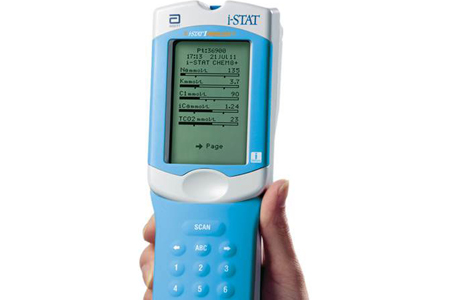

Running a Combined Chemistry/Haematology Point-of-Care Service – Why We Use the i-STAT All tests at these sites are performed by registered nurses or medical officers. Only 33 of the analyser locations have on-site laboratories the remainder are non-laboratory sites such as small rural hospitals and primary health care clinics. This network is considered the largest in the world and provides basic testing capabilities over a considerable geographical area. Here I describe the selection, management and use of the i-STAT analyser as a combined chemistry/haematology analyser in an integrated testing network consisting of 195 analysers, covering approximately 140 sites across the state of Queensland. These tests include arterial and venous blood gas and electrolytes, common metabolites, cardiac troponin I (TnI), Hct and Hb, and coagulation tests such as the INR and ACT. However, the Abbott i-STAT (Abbott Laboratories, Abbott Park, IL, USA) analyser is capable of performing a wide variety of point-of-care tests on the same instrument. Point-of-care haematology testing can be performed with dedicated PoCT analysers. These tests are usually regarded as ‘haematology’ tests and are commonly used in the management of infection, haemorrhage, and oral and intravenous anticoagulants. Whilst this attachment has continued to serve PoCT well into the 21 st century, an increasing number of testing devices are being marketed which perform tests such as the white cell count (WCC), haematocrit (Hct) and haemoglobin (Hb), prothrombin time/international normalised ratio (PT/INR), activated clotting time (ACT), and the activated partial thromboplastin time (APTT). In some institutions, this continues to be the case. This paradigm has probably arisen because historically a majority of point-of-care tests such as blood gas analysis and blood glucose testing have indeed been derived directly from clinical chemistry. PoCT is often regarded as a part or branch of clinical chemistry by many laboratory and clinical professionals. To avoid confusion, any advice given to clinical staff regarding their analysers should be clear, concise, and above all else, consistent. Test management issues should be resolved by taking the view that it is a ‘point-of-care’ test, and by looking at the specific test technology and method involved, rather than by just assuming it is a ‘haematology’ or a ‘chemistry’ test.Ĭlinical users of a combined PoCT system are principally interested in the generation of good quality results.

These views must be considered when designing an overall PoCT management plan.

Specialties other than clinical chemistry may have differing views on traditional test management, particularly with regard to quality control (QC), quality assurance (QA), and training. Such analysers, however, are invaluable in some clinical settings. The appearance on the market of small, light, inexpensive, multi-purpose, point-of-care analysers, which combine a number of widely differing analytes, has to some degree upset this paradigm. Point-of-care testing (PoCT) is traditionally considered a branch or offshoot of clinical chemistry.


 0 kommentar(er)
0 kommentar(er)
